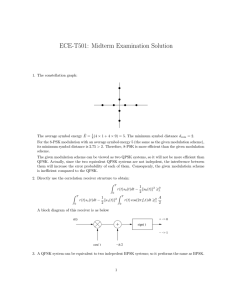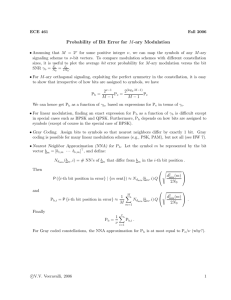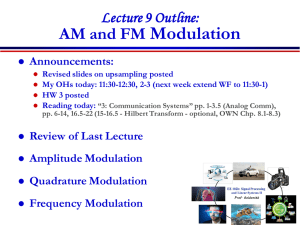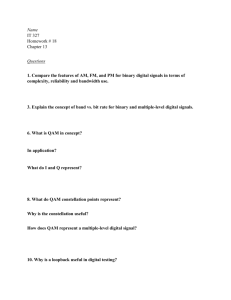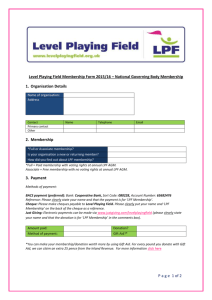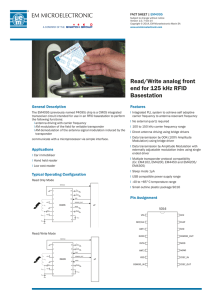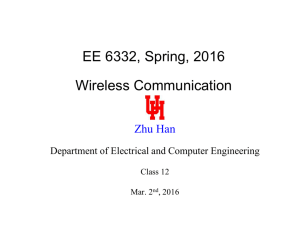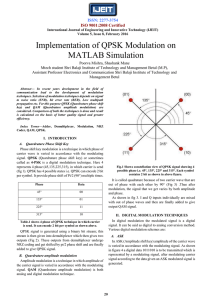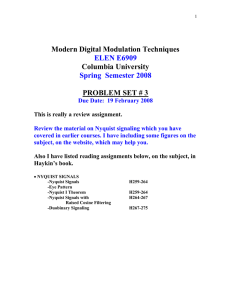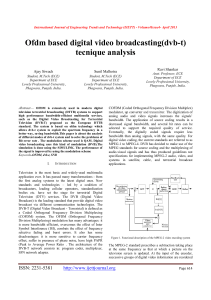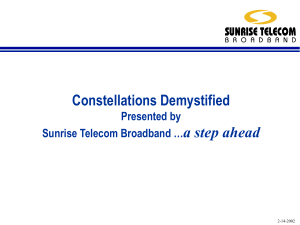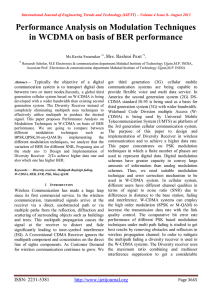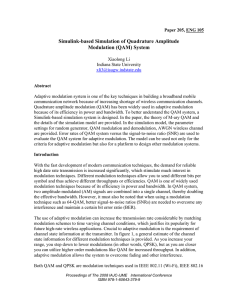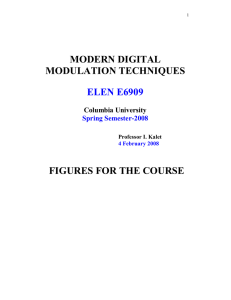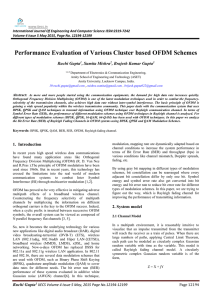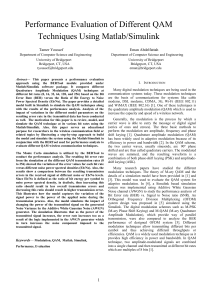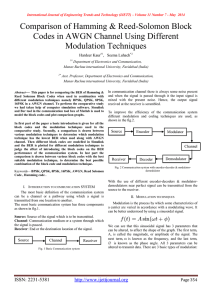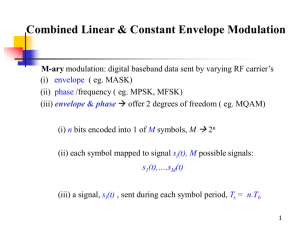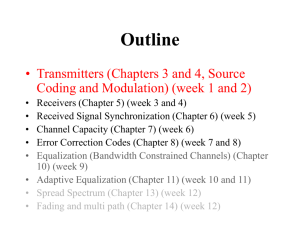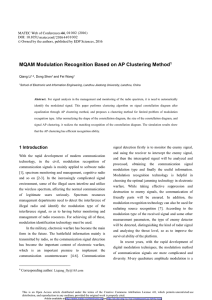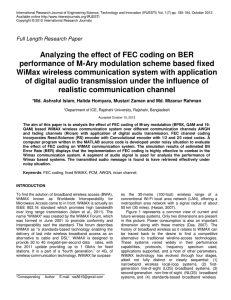Digital Communication, an overview
advertisement
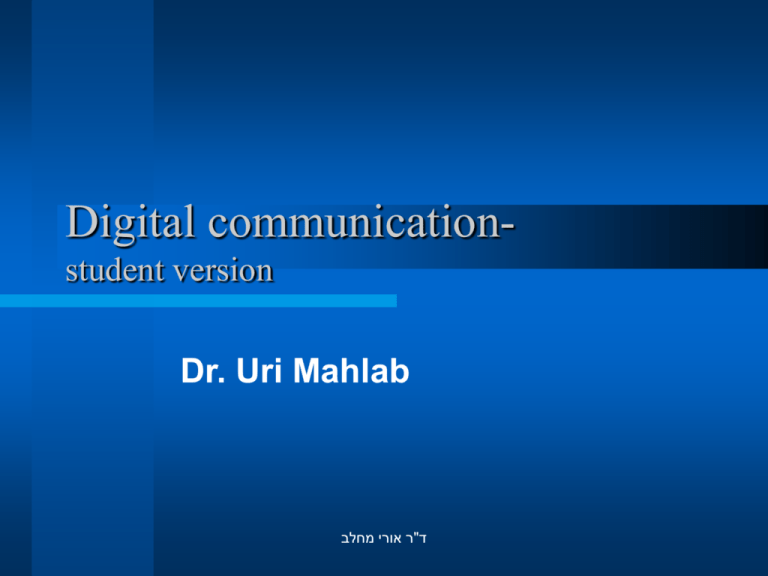
Digital communicationstudent version Dr. Uri Mahlab ד"ר אורי מחלב General overview Digital Radio Theory and Implementation -How a Digital Radio Works ד"ר אורי מחלב Digital Radio Block Diagram MOD UPCONVERTER DEMOD DOWNCONVERTER ד"ר אורי מחלב Analog vs. Digital Modulation AM FM PM DIGITAL With digital modulation information is in the phase and amplitude signal מחלבof ר אוריthe "ד The IQ Diagram Q magnitude Vq phase I Vi ד"ר אורי מחלב Analog Modulation on the IQ diagram Q FM A B I C PM D ד"ר אורי מחלב BPSK Timing and State Diagram BPSK Reference Q Constellation Diagram State 1 State 0 0 State 1 State I = 0 deg. = 180 deg. t ד"ר אורי מחלב QPSK Modulation 4 Possible States Q 01 00 Vq I Vi 10 11 ד"ר אורי מחלב 16 QAM State Diagram Q 0000 0100 0001 0101 0011 0111 0010 0110 I 1100 1000 1101 1111 1110 1001 1011 1010 ד"ר אורי מחלב Symbol Rate: “The rate at which the carrier moves between points in the constellation” ד"ר אורי מחלב Example: A 16 QAM radio has 4 bit per state (or symbol). If the radio operates at 16 Mb/s, then the carrier must change states 16 Mb/s 4 Bits or 4 million times per second (4 MBaud) SYMBOL RATE = 4MHz ד"ר אורי מחלב Some Typical Modulation Formats BPSK QPSK 16QAM 8PSK 64QAM ד"ר אורי מחלב QPSK Modulator BALANCED SYMBOL RATE: MODULATION fs = fb/2 IN-PHASE DATA STREAM 0° fb SERIAL TO PARALLEL BINARY CONVERTER I CARRIER PHASE SHIFT I.F COMBINER BPF 90° NRZ INPUT Q fs = fb/2 01 00 11 10 SIGNAL QUADRATURE DATA STREAM BALANCED MODULATION COMBINED VECTOR ד"ר אורי מחלב STATE DIAGRAM I, Q, Eye diagram and Constellation +1 I -1 +1 Q -1 EYE Q 5 3 CONSTELLATION : I 2 ד"ר אורי מחלב 1,4 QPSK Demodulator Phase Demodulation LPF. I Thresh Comp. I fb/2 IF Input BPF Power Splitter Car Rec. Phase Splitter 0° Symbol timing rec.(STR) 90° Parallel to serial converter fb/2 Q LPF. Phase Demodulation ד"ר אורי מחלב Thresh Comp. Q Binary NRZ fb 16 QAM Modulator I 2-to-4 level convert fb 2 I fb 4 Premod. LPF 0° L.F. fb Binary Data 16 QAM Phase split LO BPF NRZ Data fb 2 90° Q 2-to-4 level convert fb 4 Premod. LPF ד"ר אורי מחלב Q Output 16 QAM Demodulator I 4-Level Signal LPF fb 4 L O G I C Vth1 Vth2 fb 2 0° Vth3 BPF STR CR IF Input Regeneration X2 Data data Out fb con blner 90° Q LPF fb 2 fb 4 4-Level Signal ד"ר אורי מחלב 4-to-2 level converter of Q channel. Same design as I channel. Which waveform requires more bandwidth? A B time ד"ר אורי מחלב Bandwidth Considerations ד"ר אורי מחלב Two random data sequence time ד"ר אורי מחלב frequency Unfiltered Digital Radio Spectrum f 0 3FS f 0 3FS f 0 2FS f 0 FS f0 f 0 FS f 0 2FS ד"ר אורי מחלב f 0 3FS f 0 4FS f 0 5FS An UNFILTERD Radio frequency U/C MOD time Data is easier to recover but signal requires a lot of bandwidth D/C DEMOD time ד"ר אורי מחלב A FILTERED Radio frequency MOD U/C time Signal requires less bandwidth but data is filtered D/C DEMOD ד"ר אורי מחלב time Intersymbol Interference ד"ר אורי מחלב Nyquist Filtering Raised Cosine ד"ר אורי מחלב Filter Coefficient & Determines Required B.W. Amplitude Response 1 0.5 Linear Phase 0.3 0 (Flat Group Delay) FS Symbol _ Rate FS 2 ד"ר אורי מחלב FS The Filtering is Distributed in the Radio MOD UPCONVERTER DEMOD DOWNCONVERTER ד"ר אורי מחלב SUMMARY As the modulation complexity increases, the radio becomes more spectrally efficient. However, it also become more susceptible to errors caused by noise and distortions. ד"ר אורי מחלב P(x) THRESHOLD TOTAL PROBABILITY OF NOISE AMPLITUDE EXCEEDING THIS THRESHOLD 0.4 0.3 0.2 0.1 -30 -20 -10 10 ד"ר אורי מחלב 20 30 X How Error Occur VOLTAGE BINARY SIGNAL + AMPLTUDE NOISE FDP NORMAL 1 VALUE 1 1 ERROR DECISION 0 0 ERROR THRESHOLD NORMAL 0 VALUE Received signal with superimposed noise ד"ר אורי מחלב PROB Gaussian Distribution PROBABILITY DENSITY FUNCTION P(x) 0.4 0.3 0=RMS VALUE AFTER SUBTRACTING DC COMPONENT 0.2 NEVER RECHS ZEBO -30 -20 0.1 -10 ד"ר אורי מחלב 10 20 30 X Meaning of Eye diagram Threshold ד"ר אורי מחלב
